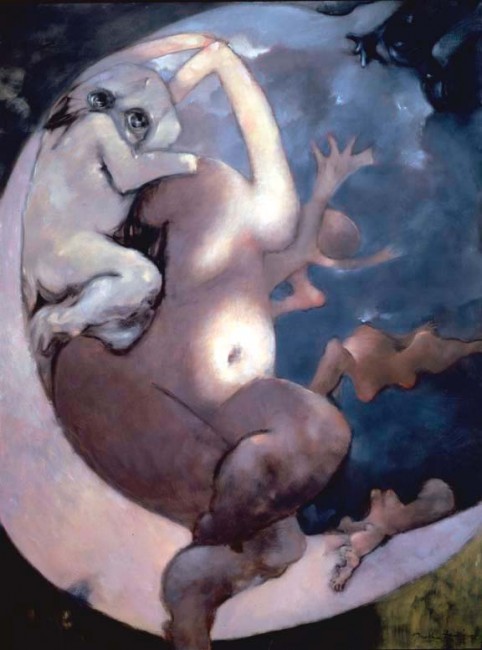melatonin
sex
this moon full hallow
float docile
and that stick of chalk you hide behind your ear
I take
to scrawl our name on the wall
inchoate
you don’t stomach sleep
only whisper
fuck me
so now there is this little dog standing on top
of my head
and it barks at every sound in the night
tireless and erratic so
so three cheers for the somnambulist
that creak creak and tapping step
three cheers for the satyr
its airy leap and woodland yelp
and one long drawn out ode for me
smooth new and soft

Murmurs -- Dorothea Tanning
Melatonin (N-acetyl-5-methoxy tryptamine) is a hormone produced by the pineal gland in animals and regulates sleep and wakefulness. It is also produced in plants as a first line of defense against oxidative stress. It was first discovered in connection to the mechanism by which some amphibians and reptiles change the color of their skin; Carey Pratt McCord and Floyd P. Allen discovered in 1917 that feeding an extract of cows’ pineal glands lightened tadpole skin by contracting the dark epidermal melanophores. But it was not until 1958 that Yale University dermatology professor Aaron B. Lerner, researching bovine pineal gland extracts as a treatment for skin disease, isolated and named the hormone. In 1975 H. J. Lynch demonstrated that the production of melatonin exhibits a circadian rhythm in human pineal glands; Massachusetts Institute of Technology neuroscience professor Richard Wurtman patented it as a low-dose sleep aid in 1995. He was also notable for his work on another hormone, dopamine (3,4-dihydroxyphenethylamine), a neurotransmitter released by nerve cells to send signals to other nerve cells; the brain includes several distinct dopamine pathways, one of which plays a major role in reward-motivated behavior that enhances incentive salience (such as desire) and positive emotions, particularly those which involve pleasure as a core component (joy, euphoria and ecstasy), promoting both appetitive behavior and consummatory behavior. Dopamine injections in the ventrorostral region of the nucleus accumbens do not increase liking, though dopamine microinjections may produce wanting (or aversion). In 1954, as a postdoctoral fellow at McGill University in Montreal, Canada, James Olds was trying to teach rats how to solve problems such as running mazes and discovered that they performed better if a brief burst of electrical stimulation was administered to specific sites in their brains; he found similar results in humans. His hypothesis was that animals engage in behavior (such as persistently pressing a bar for hours until too exhausted to continue) that has no value to the survival of either themselves or their species because the brain stimulation activates the neurological system that underlies “reward” (despite the fact that primary reward is that which encourages the survival of one’s self and progeny). Over the next two decades it was established that dopamine is one of the main chemicals aiding neural signaling in these regions, leading to its identification as and the brain's "pleasure chemical."
ReplyDelete